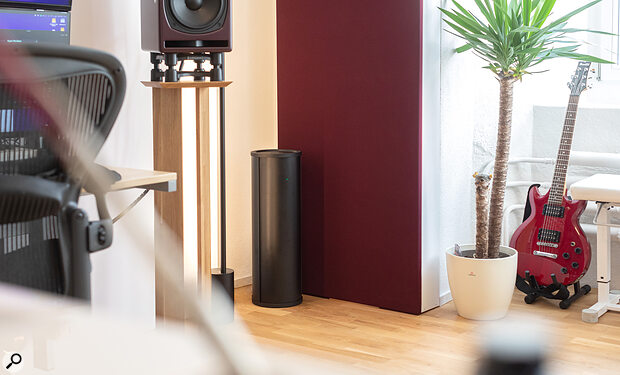Standard low‑frequency acoustic treatment needs a lot of space, but PSI’s active traps fit anywhere.
If you’re a regular reader of Sound On Sound you will be familiar with advice that goes something along the lines of: “Before you get too hung up on the sound of your monitors, you need to manage the influence that your room has on what you hear.” The significance of that advice can’t really be overstated, and even if you work in a room without a single item of acoustic treatment, having just a basic understanding of how the room might be imprinting itself on your work is better than not giving it a thought. If you want your work to translate successfully to other playback systems in other spaces, the influence of the room in which you mix is a pretty major factor.
When I mention ‘acoustic treatment’ you probably imagine I’m thinking of bass traps or absorption or diffusion panels, and yes, those kinds of products are part of the equation. But big items of soft furniture, bookshelves, curtains and carpets can also be effective tools in the battle to manage room acoustics. What all of these items have in common is that they are passive: they sit in the room and do nothing but absorb or diffuse excess acoustic energy, and as such can’t be targeted at specific troublesome frequencies.
As long as your room displays a reasonably short reverberation time at mid and high frequencies (say, less than 500ms), and isn’t prone to major flutter echoes, those troublesome frequencies tend to reside below around 150Hz, where audio energy with a wavelength that equals some multiple of the room dimensions bounces between the primary room boundaries to generate resonant room modes. We’ve all experienced that phenomenon whereby the same mix sounds bass‑light at one position in the room and bass‑heavy somewhere else. This is because the two listening positions correspond to locations where room modes respectively suppress and boost frequencies that happen to coincide with elements of the mix. It’s a cruel trick of architecture that room sizes and their resonant modes often correspond with the bass frequencies of music. If we all lived and worked in rooms three times the size, I perhaps wouldn’t be writing this review.
Cancellation Culture
Low‑frequency room modes are often dealt with using passive bass traps, which dissipate low‑frequency energy either through plain absorption or a damped low‑frequency panel resonance. Such passive bass traps can be highly effective, but they need to be pretty large, and so typically consume significant studio real estate. However, in 2016, Swiss monitor company PSI Audio launched an alternative approach to bass trapping in the shape of the AVAA C20 active bass trap, which SOS Technical Editor Hugh Robjohns reviewed in that year’s August issue. The AVAA C20 looks a little like an active subwoofer, but it conceptually operates in reverse, reducing bass energy in the room rather than increasing it. It achieves this by employing a microphone to sense instantaneous acoustic pressure in the room, the analogue of which is then used to control the motion of an array of amplifier‑driven subwoofer‑style drivers in order to equalise the acoustic pressure. When the pressure rises with the arrival of a low‑frequency peak, the drivers move backwards to reduce it, and if the pressure drops on the arrival of a low‑frequency trough, the drivers move forwards to increase it. The principle is related to that employed in noise‑cancelling headphones, just on a grander scale. Normalising the acoustic pressure means that low‑frequency energy arriving at the bass trap, rather than being reflected back into the room, is effectively evaporated. The result is that the low‑frequency resonant room modes are suppressed. Hugh’s review of the AVAA C20 concluded that it worked very wel, and PSI have now introduced their second active bass trap: the...
You are reading one of the locked Subscribers-only articles from our latest 5 issues.
You've read 30% of this article for free, so to continue reading...
- ✅ Log in - if you have a Subscription you bought from SOS.
- Buy & Download this Single Article in PDF format £1.00 GBP$1.49 USD
For less than the price of a coffee, buy now and immediately download to your computer or smartphone.
- Buy & Download the FULL ISSUE PDF
Our 'full SOS magazine' for smartphone/tablet/computer. More info...
- Buy a DIGITAL subscription (or Print + Digital)
Instantly unlock ALL premium web articles! Visit our ShopStore.


